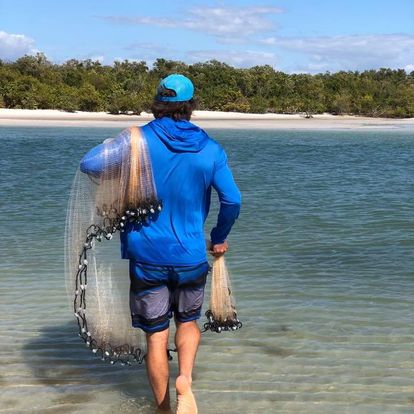
Knowing how to catch Ballyhoo is an essential skill to learn if you target large predator fish. Here is my comprehensive guide to catch more Ballyhoo.
How To Catch Ballyhoo
Ballyhoo are known to congregate heavily around reefs, wrecks, and depth changes in the ocean where they are caught using various fishing techniques, including cast netting, hoop netting, or hook and line. Regardless of the method used, chumming the water is essential for success.
Catching Ballyhoo With A Cast Net
The most effective method for catching large numbers of Ballyhoo is by using a cast net. When it comes to cast netting Ballyhoo, having the right tackle/material is essential for success.
Choosing The Best Cast Net For Ballyhoo
The first thing you will need is a properly sized cast net. I recommend using an 8′ to 12′ net with a ⅜” to ¾” mesh.
If I am targeting Ballyhoo in deep water, it is essential to use a cast net that has a wider mesh size, like a ¾”. Using a larger mesh size minimizes the drag of the net in the water increasing the rate at which it sinks on the Ballyhoo.
If I am targeting Ballyhoo in shallow water, which I would consider depths less than 10′, I will throw the ⅜” mesh net, which will sink slower than a cast net with a larger mesh size.
Throwing a smaller mesh net is often worth it in shallow water because a smaller mesh size will limit the number of Ballyhoo or other baitfish that become gilled and die in the net.
Now when it comes to the size of the cast net, I recommend that beginners start with an 8′ cast net and increase size as you master throwing it. What I consider mastery is the ability to throw perfect circles over the bait repeatedly.
I started as a kid throwing an 8′ net, eventually increasing to a 10′ and now comfortably throwing a 12′.
So now that we have the proper net selected, it’s time to catch some Ballyhoo. If you follow this Five-step guide, you will catch more Ballyhoo… Guaranteed.
Five-Step Guide To Catch More Ballyhoo With A Cast Net
- Anchor up current: The first step to catching Ballyhoo is anchoring up current of the structure you will be targeting them. When the boat is anchored on the reef, wreck, or patch reef, it’s time to get some chum in the water.
- Get Chumming: Next, you will want to get your chum in the water. I recommend chumming with multiple chum bags on the left and right stern of the boat (rear). Chumming from two different points will increase the overall size of your chum slick, which will ultimately bring more Ballyhoo closer to the boat. You will want to give the Ballyhoo at least 5 min to start congregating in a heavy school before even thinking about moving to the next step. Side Note: Chum is not the area you will want to skimp and get the cheap stuff. Ballyhoo have extremely small mouths, so you will want a double ground chum that is extra fine. I have always had the best success fishing the extra-fine chum block by Tournament Masters. You will be paying 30% to 40% more per block, but it is definitely worth it.
- Throw out some oats: Now that 5 to 10 minutes has passed, it’s almost time to get that net in the water. Right before I throw the net over the school of Ballyhoo in the chum slick, I will have another person on the boat throw a hand full of oats into the water. Throwing the oats in the water is one of the fastest and cheapest ways to get the Ballyhoo to surface completely
- Throwing the net: As soon as the oats hit the water, throw the net right on top of them and allow your net to sink for 5 to 10 seconds until your cast net rope is tight in your hands. As soon as the rope becomes tight, make two to three strong pulls on the cast net rope. These pulls will help the net close quicker than simply pulling in the net smoothly.
- Repeat: Chances are you will have caught quite a few Ballyhoo on your first cast. If you did not catch as many as you need for your day fishing, repeat the steps over again until you’re prepared for your fishing day on the water.
Another method to catching Ballyhoo is using the hoop net method.
Hoop Netting Ballyhoo
Hoop netting Ballyhoo is very similar to the steps used when catching Ballyhoo with a cast net, except instead of casting, you will quickly retrieve your hoop net throw the water column catching Ballyhoo on the retrieval.
Hoop netting is a great way to catch Ballyhoo, especially when Ballyhoo is hesitant to come close to the boat since cast netting Ballyhoo at long distances is nearly impossible.
Catching Ballyhoo On Hook And Line
The first two methods of catching Ballyhoo are excellent methods to catch large quantities of Ballyhoo but are not the ideal method to catch them if you are hoping to keep them alive.
Ballyhoo are extremely delicate baitfish, often dying within minutes of being cast netted.
To keep Ballyhoo alive, you will want to use the Hook and line method.
This method of catching Ballyhoo can be achieved by either using a Sabiki rig, a multiple hook fishing rig, or simply by fishing a single small hook and some form of cut bait.
Catching Ballyhoo On Sabiki
As with the other methods of catching Ballyhoo, you will want to anchor up current of the structure you are targeting them and begin to chum. Unlike the other methods, there is no need to wait for them to congregate. Instead, the moment you are anchored, you can cast your Sabiki towards the school of Ballyhoo.
The retrieval is simple you will want to bounce the tip of your rod erratically, which will typically spark their interest, causing them to strike.
Catching Ballyhoo on Sabaki is quite simple if you have the right tackle. I recommend fishing with a sized four Sabiki with a ⅜ ounce weight.
Catching Ballyhoo With A Single Hook
Many anglers despise using Sabiki rigs because they can be dangerous and a nuisance to use.
If your in the anti-Shabiki boat, Ballyhoo can still be caught using small bits of shrimp tipped on a #12 hook. One benefit of using this method is it is the best method to keep Ballyhoo alive since there are no net or additional hooks to damage the fish.
When Can You Catch Ballyhoo?
Ballyhoo can be caught year-round, with early winter being the most productive time to catch them in tropical waters and summer being the best time to catch them in subtropical waters.
Where Do You Catch Ballyhoo?
Ballyhoo is caught on reefs, wrecks, and other submerged structures in tropical and subtropical waters. Though Ballyhoo can be caught in various depths, they are typically most abundant in 5′ to 25′ of water.
What Are Ballyhoo?
Hemiramphus Brasiliensis commonly referred to as Ballyhoo, Halfbeak, or Hoo, is a marine fish that is used as bait for many predator fish, including but not limited to Mahi-Mahi, Tuna, Wahoo, Sailfish, and Snapper.
Ballyhoo are predominantly found in tropical waters where they congregate on shallow water structures, including grass flats, reefs, wrecks, and areas of changing depth.
Ballyhoo are submarine-shaped baitfish that sport a halfbeak on their bottom jaw. Ballyhoo has dark blue backs that slowly fade to white towards the belly of the fish.
Is Ballyhoo A Good Bait?
Ballyhoo are an excellent bait. In fact, no other bait has caught more pelagic fish than Ballyhoo. Ballyhoo are used for both pelagic and benthic fish alike and has been a staple in the fishing world for years
Fish Can You Catch With Ballyhoo
- Sailfish
- Marlin
- Wahoo
- Mahi-Mahi
- Snapper
- Grouper
- Shark
Is Ballyhoo Fish Good Eating?
Ballyhoo is not a fish commonly caught to eat, but those who have consumed them state that the flesh is extremely oily and fishy.
